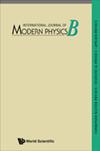A new type of supercontinuum generation in hexagonal lattice C6H6-core PCF with broadband and low-power pump
IF 2.8
4区 物理与天体物理
Q2 PHYSICS, APPLIED
引用次数: 0
Abstract
Most of the spectral bandwidths of previous publications are still limited by high input powers making them economically less than ideal. By using a benzene core (C 6 H 6 ) photonic crystal fiber (PCF) as a new supercontinuum (SC) light source, it is possible to achieve a very large spectral broadening with hundreds of times lower peak power. Due to the change in the diameter of air holes in the first ring near the core, near-zero flattened dispersion, high nonlinearity and small attenuation can be achieved for spectral broadening. The structural geometries of two C 6 H 6 -PCFs are optimized to generate wide SC at low input energy. The SC spectrum produced in 1[Formula: see text]cm long of all dispersion fiber extends from a part of visible light to the near-infrared range at 1.3[Formula: see text][Formula: see text]m wavelength and a small pulse energy of 18[Formula: see text]pJ (or 450[Formula: see text]W of electrical input). The second PCF shows wide soliton-induced SC from 0.8 to 4.2[Formula: see text][Formula: see text]m with 71[Formula: see text]pJ pulse energy (or input power approximately 790[Formula: see text]W) at 1.5[Formula: see text][Formula: see text]m wavelength within a fiber of 12[Formula: see text]cm. The proposed structures have the potential to become a new class of microstructured optical fibers for low-cost, broad-spectrum SC generation.六方晶格c6h6核PCF的一种新型超连续谱产生方法
以前发表的大多数频谱带宽仍然受到高输入功率的限制,这使得它们在经济上不太理想。利用苯芯(c6h6)光子晶体光纤(PCF)作为一种新型的超连续光谱(SC)光源,可以在峰值功率降低数百倍的情况下实现非常大的光谱增宽。由于核心附近第一环气孔直径的变化,可以实现接近零的平坦色散、高非线性和小衰减。优化了两种c6h6 -PCFs的结构几何形状,以在低输入能量下产生宽SC。所有色散光纤长1厘米产生的SC光谱从可见光的一部分延伸到近红外范围,波长为1.3[公式:见文][公式:见文]m,脉冲能量为18[公式:见文]pJ(或450[公式:见文]W的电输入)。第二个PCF显示出宽孤子诱导的SC从0.8到4.2[公式:见文][公式:见文]m, 71[公式:见文]pJ脉冲能量(或输入功率约790[公式:见文]W)在波长为1.5[公式:见文][公式:见文]m的光纤内12[公式:见文]cm。所提出的结构有潜力成为低成本、广谱SC生成的新型微结构光纤。
本文章由计算机程序翻译,如有差异,请以英文原文为准。
求助全文
约1分钟内获得全文
求助全文
来源期刊

International Journal of Modern Physics B
物理-物理:凝聚态物理
CiteScore
3.70
自引率
11.80%
发文量
417
审稿时长
3.1 months
期刊介绍:
Launched in 1987, the International Journal of Modern Physics B covers the most important aspects and the latest developments in Condensed Matter Physics, Statistical Physics, as well as Atomic, Molecular and Optical Physics. A strong emphasis is placed on topics of current interest, such as cold atoms and molecules, new topological materials and phases, and novel low dimensional materials. One unique feature of this journal is its review section which contains articles with permanent research value besides the state-of-the-art research work in the relevant subject areas.
 求助内容:
求助内容: 应助结果提醒方式:
应助结果提醒方式:


